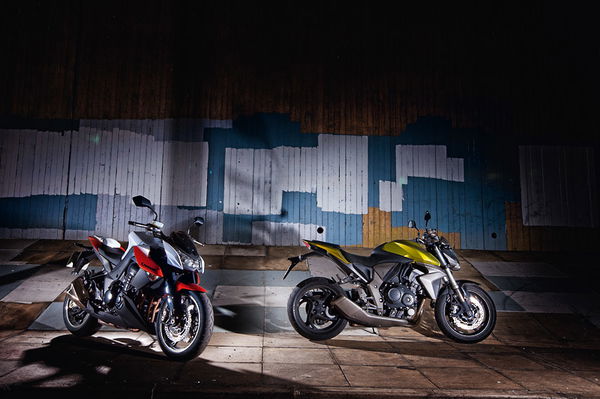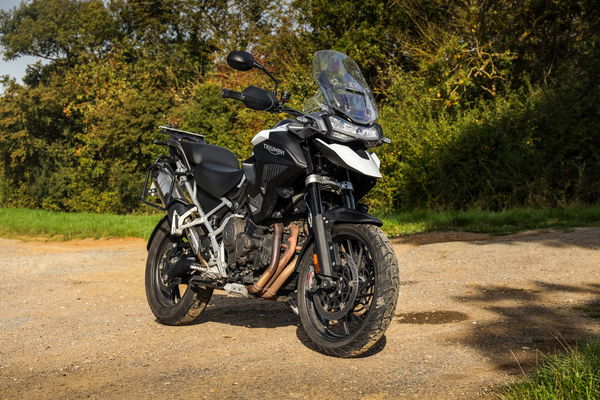Four. Three. Two. One. Cylinders test
For many riders pure sports bikes are becoming less and less relevant. But what are the options in the middleweight class? That depends how you like to ride and how many cylinders you want…
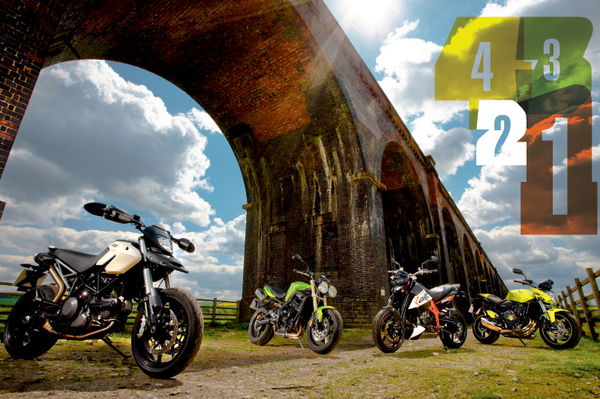
Triumph Street Triple
A bike for the masses, for novices, for experienced riders, for the whole world in fact. It’s very, very good – But such a shame it whines like a K-series BMW at tickover
Click to read: Triumph Street Triple owners reviews
At first peek, Triumph’s highly acclaimed Street Triple can look a little unfinished. The frame inserts that cap either end of the swingarm pivot look as though there’s a cover missing, the visible coolant hoses and cables look like someone’s crashed it and couldn’t afford to replace the body panels. And to cap off the homemade Steetfighter look there’s a pair of eighties-refugee chrome ’bars and twin chrome Bates-style headlights. Chrome? Remember chrome?
But the unfinished appearance is deceptive. The baby Triumph triple is probably the best developed, best engineered and the most together bike among this oddball quartet and it’s probably for this reason that Triumph is selling shedloads of these easy-to-master bikes all over the globe.
Prod the starter button and the 675cc triple whines into action. It’s an odd noise at idle, gear whine is the dominant sound and it’s not until you blip the throttle that the off-beat power strokes make themselves heard. The noise is a mix of K-series BMW (the whine) and the hard rasp of an air-cooled 911 Porsche.
But the more you explore the triple’s 13,000pm rev range, the better it starts to sound. With the throttle valves wide open the moan of induction noise becomes the dominant sound.
It’s really free-revving too and the way the revs rapidly drop suggests there isn’t much crankshaft mass whirling away inside the cases.
But this doesn’t mean the baby Triumph loses any flexibility or the ability to drive from low revs. Far from it. When the mood dictates a more leisurely riding pace the Triumph happily grunts from low revs and pulls strongly, cleanly and glitch-free from idle to rev limiter. Part of the reason is the immaculate fuelling and the smooth pulses of the 120-degree crank. Whether you want to chug along or thrash the tatters off it, the Triumph’s 675cc motor caters for all.
You might suspect the Street Triple’s just a Daytona with all the expensive bits ripped off it – but you’d be wrong. The chassis balance is totally different. Where the razor-blade-like 675 Daytona is totally focused around the front tyre, insanely fast corner entry and mid-turn velocity, the Street Triple is far more road and real world oriented. Just bouncing up and down on the seat with both your hands on the back of the tank speaks volumes. Both the front and rear suspension compress and rebound at exactly the same rate. It’s quite softly sprung and softly damped but it’s the fore-aft balance that’s impressive. Where the Daytona is really not happy unless you’re in maximum-attack mode, the Street Triple is far more of a jack of all trades and it’s the nicely balanced chassis set-up that’s the key to this flexibility.
Equally sorted is the clutch. Bite and take up is soft and progressive making it a far easier ride than any of the other bikes here. Just manoeuvring around town or creeping forward at a junction the lever ratios and mechanism give masses of control and feedback which is probably just as important for a new rider as it is for one with masses of experience.
Downsides? The steering lock is abysmal. You know it’s bad when even a trellis framed Ducati offers more U-turn flexibility. At least the Triumph’s seat is low enough to allow flat-footed shuffling as you perform yet another 76-point turn. The gearbox needs a healthy throttle blip on downshifts to match engine and road speed – to avoid the meshing dogs sounding like a spanner dropped down an iron pipe. While it may not be Suzuki-slick, it’s far from bad.
Everyone who rode the Triumph grew to love its easy-riding nature. It’s just plain flattering – whoever you are, however you ride. Who’d have thought a Triumph would feel more like a Honda than the Honda?
Triumph Street Triple Specifications
Price £6,299
Top speed 141mph Engine 675cc, 12 valves, liquid-cooled, in-line triple
Bore and stroke 74mm x 52.3mm Compression ratio 12.6:1
Power 107bhp at 11,700rpm Torque 50ft/lbs at 9,100rpm
Front suspension 41mm telescopic fork Adjustment Preload, compression and reboud
Rear suspension Monoshock Adjustment Preload, compression and reboud
Front brakes Four-pot calipers, 308mm discs Rear brake Twin-pot caliper, 220mm disc
Wet weight 167kg (368lbs) Seat height 805mm Fuel capacity 17.4 litres
Colour options Green, Red, Yellow, Black
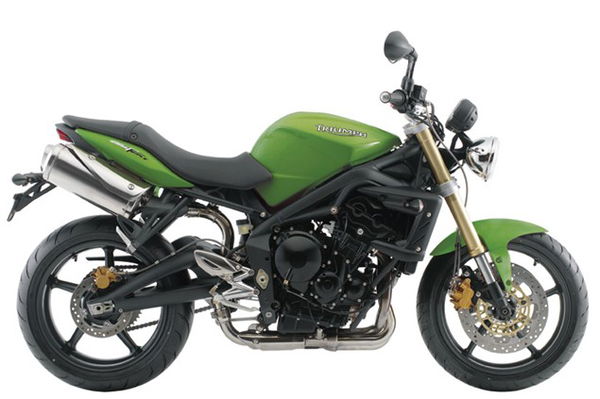
KTM Duke R
KTM Duke R
Very powerful for a single, hard to ride and expensive. But very nicely bolted together and faster than a lot of other tackle. Not many bad vibes either. Interesting bike
Click to read: KTM Duke R owners reviews
Nuts. Totally nuts. This physically diminutive engine produces more power than a Ford Ka from just one short-skirted piston that sweeps a displaced volume of just 695cc. It may not be an easy thing to ride in most situations but there’s certainly no denying that this is the pinnacle of one-lunged technology in a street legal bike.
72bhp from just one barrel is impressive. Even more impressive is how KTM have managed to silence it so much that you can barely hear it without sacrificing massive amounts of power. That in itself is a technological master stroke.
The engine’s dinner table manners are pretty ropey, though, but if you pull the pin and ride it like you’re trying to set a new class lap record, it’s perfect. The amount of grip you can find as you lay down the power out of a turn is incredible. Absolutely incredible. The motor responds with lightning speed to throttle inputs and barks its way through all six gears in the blink of an eye. Back to back in a throttle-nailing, through the gears competition the KTM even fended off the bigger capacity Hypermotard 796. Stupidly fast, it is.
But bopping along through town or keeping it slow with snail-pace traffic, the KTM is a bitch to ride. The part throttle fuelling (with the mapping in any mode) is dreadful and the glaring lack of flywheel mass means that between every bang-bang-bang power-stroke it just wants to stop dead. You can adapt to this by riding the clutch to smooth out the lumpy power delivery but it’s not something a new rider would find particularly easy, that’s for sure. To the inexperienced, the KTM would be the bike of a thousand un-planned, embarrassing stalls.
It’s raucous, single-minded nature certainly divided opinion among our testers. Hogan claimed he’d rather push it back to London than ride it but I think that was unduly dramatic.
I think this mad-ass KTM’s appeal lies in who you are, how you ride and, more importantly, where you live and what kind of riding you do. Obviously, as the most expensive bike in this bunch, it also depends on what qualities you cherish and how flexible your credit card is. There’s no disputing that it’s a luxury item at £7,395.
I know two people who haven’t yet ridden the KTM that would absolutely love it. Crucially they both live in the Lake District and are both ex-motocrossers of national standard. They’ve cut their biking teeth on a whole succession of single-piston, wide-barred mud flingers. It goes without saying that when they ride on the road they only know one way to ride and that is with the throttle cable stretched at all times. They’d both really get the KTM’s purpose in life. It’d be at it’s best grabbing massive air over bumpy crests, backing in to tricky uphill hairpins and wheelying over cattle grids and the like.
But that could describe any supermoto styled big single couldn’t it? Where the Duke R scores is its ability to deal with smoother, faster stuff. There’s an unbelievable amount of power on tap to allow sustained high speed cruising. Its drive from 70mph in top gear is astounding. The lack of vibes throughout the whole rev range left me impressed, too.
Fuel maps can be toggled between but it’s not as simple as on other bikes where the options are handlebar-mounted and can be flicked through on the move or, at worst, in neutral. The ‘options’ menu sits under the seat behind a waterproof rubber boot. It’s a bit of a faff, to be honest and the difference between ‘full’ power and ‘soft’ hard to differentiate between. Mad bike though.
KTM Duke R Specifications
Price £7,695
Top speed 112mph Engine 690cc, 4-valve, liquid-cooled single
Bore x stroke 102mm x 84.5mm Compression ratio 12.5:1
Power 71.4bhp at 7,50orpm Torque 48.6 lb/ft at 7,750rpm
Front suspension 48mm WP inverted forks Adjustment Compression, preload and rebound
Rear suspension WP Monoshock Adjustment Compression, preload and rebound
Front brakes 1x 4-piston Brembos, 320mm disc Rear brake Twin-piston caliper, 245mm disc
Dry weight 165kg (364lbs) Seat height 865mm Fuel capacity 13.5-litres
Colour options Black/orange
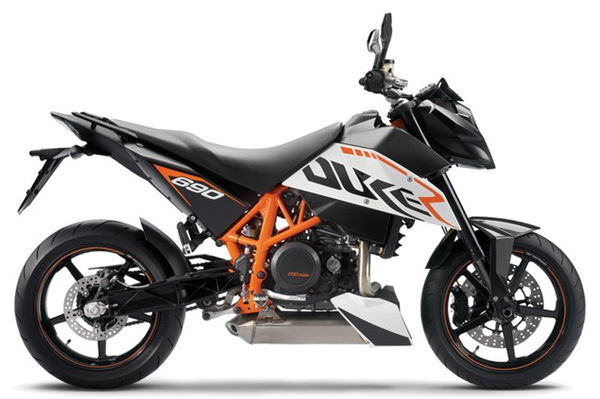
Ducati 796 Hypermotard
Ducati 796 Hypermotard
Uncomfortable for just about any shape of rider, but easy to ride with a versatile, economical but long-in-the-tooth engine. Get a monster 796 instead. Go on, get one
Click to read: Ducati 796 Hypermotard owners reviews
Possibly the weirdest riding position of any bike I’ve ever ridden, the Hypermotard plonks you on top, leant forward with your arms wide apart. To compound this feeling of strangeness, the flip-out, bar-end wing mirrors add to the whole illusion of width. They also make filtering a real hit (quite literally) or miss affair.
That said, the 796, is an easy ride. It’s evidence of just how far Ducati have come over the past decade or so. A civilised Ducati? Who’d have thought that a reality in the 1990s?
Flick the sliding kill switch to expose the starter button and the Hypermototard motor churns into life, settling into a quiet and lumpy idle almost instantly. There’s no rattling dry clutch, no booming tailpipe noise – just a whir of toothed belts and a muted exhaust note.
The desmodromic heads in the 796 run two-valves per cylinder and, for road use, it’s a good combination. Coupled with the increase in capacity (now 803cc) the two-valve layout produces a large amount of low down and mid-rage torque. This basic engine design has been around for over 30 years now and it’s easy to see why when this latest incarnation is so good. Vibration is non-existent, and with over 80bhp (claimed) and 56ft/lb of torque there’s more than enough stomp to provide plenty of giggles. It’s also capable of delivering nearly 60mpg, too.
It’s exactly the same powerplant as you’ll find in the new Monster and this niche marketing around a common engine is central to Ducati’s philosophy. They’re a small company and it’s a more cost efficient method of broadening your range. They’re also incredibly lucky the air-cooled L-twin is so versatile.
The Hypermotard is compromised by its market-forced position in several areas .Firstly there’s the long travel suspension. Accelerate hard, then brake hard and the front-rear pitch is comically exaggerated by the wing mirrors. So great is the length of the suspension travel that the mirrors see nothing but sky at full compression and nothing but road at full extension. The downside of all this travel is that it shifts the weight distribution so much. Not great if you’re carrying a passenger and not great unless you’re prepared to ride supermoto-style with your foot down and the back end slewing sideways into a corner. Not for everyone, that.
The other obvious compromise is the wide-armed riding position. At anything above the legal limit it’s like being nailed to a cross in a force ten gale, your body becomes a parachute and at higher speeds this unweights the front tyre making it nervous and wobbly at speed.
The third compromise is the lofty seat height and odd riding position. Our testers had a variety of builds and nobody actually looked comfortable on the Hypermotard. Who would by a Hypermotard when, for less money, there’s the beautiful Monster 796 in the same range.
Ducati 796 Hypermotard Specifications
Price £7,150 (£7,350 in red)
Top speed 120mph Engine 803cc, 4-valve, air-cooled V-twin
Bore & stroke 88mm x 66mm Compression ratio 11.1:1
Power 81bhp at 8,000rpm Torque 55.7lb.ft at 6,250rpm
Front suspension 43mm Marzocchi USD Adjustment None
Rear suspension Monoshock Adjustment Spring preload and rebound
Front brakes 2 x 4-pot Brembos, 305mm discs Rear brake Twin-piston caliper, 245mm disc
Dry weight 167kg (368lbs) Seat height 825mm Fuel capacity 12.4 litres
Colour options Red, White, Black
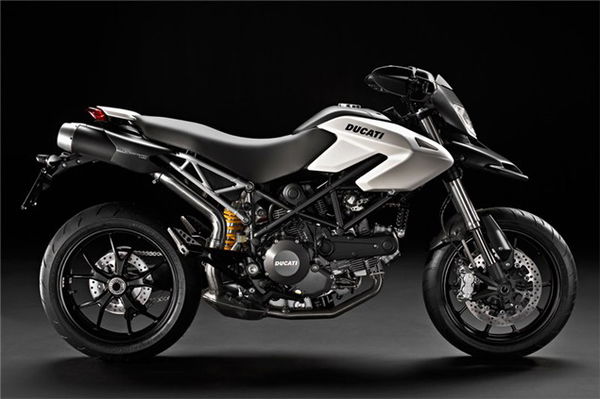
Honda Hornet 600
Honda Hornet 600
Shows its age in this company. Vibey, thrashy and frankly coming over a bit too french for everyone’s taste. But still OK if the money’s right (just don’t ride the Triumph)
Click to read: Honda Hornet 600 owners reviews
Well time may be marching on but the Honda Hornet is the only one in this group that’s really showing its age. Look closely around the headlight – they’re crow’s feet.
No amount of Botox injections could disguise the fact that the Hornet is at the end of its competitive reign in this alternative middleweight class. Just riding it a few yards tells it like it is.
The first thing you notice within just a few yards of forward travel is how much high frequency vibration there is. You feel it through the bars, through the footrests and even the gear lever tip. The vibes are exaggerated by the fact you have to wring the Hornet’s neck and thrash it to within an inch of its redline to keep up with all the other bikes here. More revs equals more tingling vibration. It’s not slow, it’s just physically quite demanding to ride in this company. You’ve got to work it (baby).
Jump from the Triumph to the Hornet and it’s like stepping back a decade – hardly surprising really as the Hornet’s been around for over twelve years now with just a bit of lippy and an Essex facelift applied in the middle of the noughties.
The fluoro shell suit you see it wearing in these pics wasn’t universally well accepted by our gallant test team either. I thought it looked like something you’d see in the car park at the Bol d’Or. The French-ness extending to fluoro lime yellow pinstripes around the wheel rims. Nice. If you like that sort of thing. The Triumph wore its look-at-me green-ness without quite as much pressure on the eyeballs. And it’s a better bike by some margin.
But before you think I’m pulling a massive downer on the platinum-selling 600 Hornet, don’t. It’s not all bad news. Well, not entirely.
It’s still really easy to ride and it’s only the Triumph’s brilliance that makes it feel sub-standard in almost every dynamic aspect. The riding position is comfy – arse low, arms out straight and all the controls are really light and predictably consistent in their actions. The fuelling’s not bad either but, again, it’s not as crisp and controllable as Hinckley’s finest.
There’s enough poke from the inline four motor to provide plenty of fun but the softly sprung and damped suspension gets its knickers in a twist over the majority of road imperfections.
Same too with the brakes. They lack the initial bite we’ve come to expect from modern stoppers and I found myself using all four fingers on the front lever when we upped the pace a bit.
I’m writing this and starting to feel a bit sorry for the little Honda and a bit guilty about all the owners I’m currently pissing off. I know how good you can make a Hornet – the massively oversubscribed race series was vivid proof of how brilliant they can be with sensible mods. It just seems that no one told Honda what those mods were and when they should make them. Which is a shame. And it begs this question: if Ducati can squeeze 30-years loyal service from an engine by constant updates, what stops a global manufacturer like Honda from doing the same to a not entirely shabby engine like the Hornet’s?
But there again, if you’re new to biking and your local Honda dealer is a thoroughly good egg, you won’t regret buying a Hornet 600 if their price is right. It will undoubtedly give you years of trouble free service and cost very little to keep ship-shape. It’s a Honda for heaven’s sake. The only piece of advice I’ll give you if you’re already embarked on the Hornet path is – for God’s sake don’t ride a Street Triple after you’ve already signed on Honda’s dotted line…
Honda Hornet 600 Specifications
Price £6,605
Top speed 130mph (est.) Engine 599cc, 16v, liquid-cooled, in-line four
Bore & stroke 67 x 42.5mm Compression ratio 12:1
Power 80bhp at 12,000 rpm Torque 45lb-ft at 9,750 rpm
Front suspension Inverted 41mm forks Adjustment None
Rear suspension Monoshock Adjustment Preload
Front brakes Three-piston, 296mm discs ABS Rear brake Single-piston, 240mm disc ABS
Wet weight 204kg Seat height 820mm Fuel capacity 19-litres
Colour options Gold, Green, Black, Grey
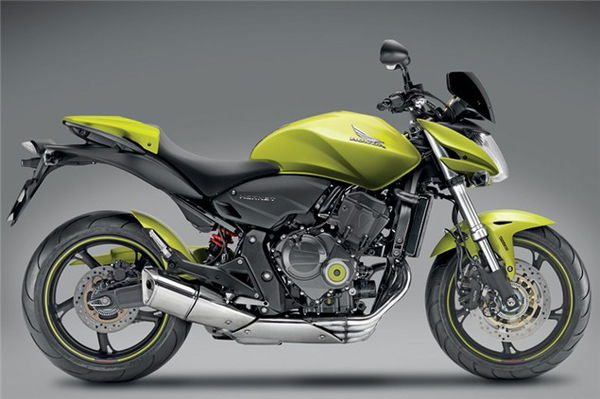
Verdict
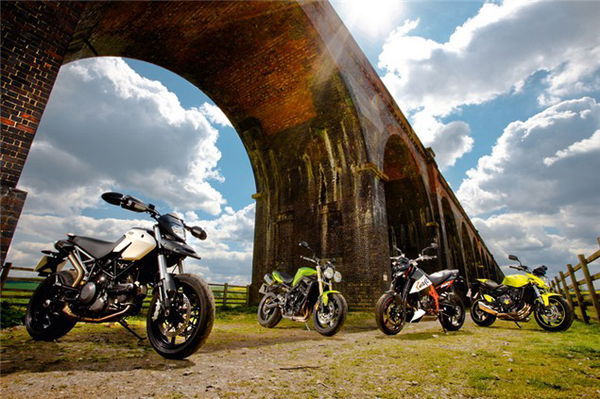
Top Triumph totally trounces all-comers
If you’ve already decided that sports bikes aren’t for you any more, this eclectic bunch shows that your choice is far from restricted. To say this load of middleweights are varied in their personalities would be a whopping understatement.
I feel a bit sorry for the little Honda Hornet, sitting here rubbing my new beard, pondering the last few days together. It’s been a cracking bike for the big H, giving many new bikers their first taste of proper performance but all wrapped up in a rider-friendly, soft and cuddly package that delivers no horrible surprises. But the old girl’s beginning to show some real signs of ageing and it’s hardly surprising because although the Hornet received a bit of a facelift a few years ago, the basic package is now more than a decade old. If you rode a Hornet in isolation you’d probably love it but back-to-back with the stunning Triumph Street Triple and you’d see what we meant. It’s not a bad bike, don’t get us wrong – it just feels old, a bit saggy and in need of a massive redesign. However, if you like high frequency vibrations and let’s face it the Ann Summer’s chain isn’t stock listed for nothing, the Hornet may just be for you.
The Hypermotard and particularly the barking mad KTM Duke R might appeal to people who live in rural areas with a playground of deserted B-roads to play the hooligan on. Might appeal? No, definitely will appeal.
If you don’t know the road in Cumbria between Kendal and Newby Bridge over Scout’s Scar and Strawberry Bank the following statement will be lost on you a bit, sorry. This bumpy, jumpy, undulating snake of rough tarmac is the Duke R’s natural stomping ground and if there was a race between these two points no other bike on the planet would get near it – even John McGuinness on his factory Fireblade. In the stretch of just ten miles you get airborne 37 times and with its long travel WP suspension the hair-trigger Duke would be perfectly composed and the fastest thing that ever graced this challenging road.
The Ducati lacks the stomp of the Duke R even though it has a few more horses. The weight difference between the two similarly styled bikes makes all the difference when you’re powering out of a turn. The Ducati is a lot more leisurely in its delivery. The KTM, by comparison is rabid.
It’s the riding position of the Hypermotard that limits its appeal. Yes, we know it’s only a set of Renthals away from improvement but in stock trim those wide bars are just too low and too wide. The flip-away mirrors don’t help here either, and just make something already wide feel even wider.
Finally, in the green corner, sits the strangely styled Street Triple. If you’d never ridden one, you’d have no idea how absolutely feckin’ brilliant this 675cc triple is. Our hats are doffed in the direction of the development team responsible for this little gem. Every single component gels with another in a smooth emulsion of togetherness. Genius. It even sounds fantastic.
Although they share a plethora of parts, the company’s 675 Daytona is more of an acquired taste with its rev-hungry motor and razor sharp, front-end focused steering. They couldn’t feel more different. The Street Triple is far more adaptable, far more flattering and, if you ask me (or any of us here for that matter), far more fun in 99% of road riding conditions. Go and try one...
